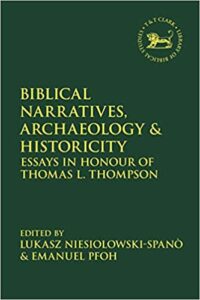
Let’s return to having a closer look at some of the chapters in the book I described back in August this year. (Actually my recent post History. It’s Long Lost Dead and Gone began as a closer look at Niels Peter Lemche’s chapter titled “What People Want to Believe: Or Fighting Against ‘Cultural Memory'”, but since I’ve discussed the same thoughts of Lemche in many earlier posts I somehow ended up with my own little bottom-line spiel instead.)
In the chapter “The Abraham and Esau-Jacob Stories in the Context of the Maccabean Period”, author Łukasz Niesiolowski-Spanò [NS] seeks to understand the most plausible context from which those stories originated. I know some readers will be as interested as I am in his approach. I address a few — not all — of the arguments in the chapter. I will cover the stories of Jacob and Esau in the next post.
Abraham

NS points out that in the book of Genesis Abraham is “depicted as a figure disconnected from any historical realities, by being alien and of a nomadic way of life.”
The stories connected with Abraham are set within the mythical illo tempore, in the same way as Greek heroes are described in un-historical realities of the tragedies or Homeric epic for which a coherent historical background does not exist. (NS, p.50)
NS zeroes in on two moments in the Abraham story that he considers the most important:
- the covenant between God and Abraham promising Abraham multitudes of descendants who become God’s chosen
- the sacrifice of Isaac (the Akedah)
Begin with that second episode. NS views it as dramatizing the kinds of complex theological questions we elsewhere encounter in books like Job and Ecclesiastes. To what extent is the pious person expected to obey and trust God? Is the reward expected to be in this or the next life? The problems facing Abraham point to sophisticated philosophical (or theological) quandaries of the sort that preoccupy intellectual elites. The story does not come from popular folklore, surely. Rather,
it is a reflection of the Jewish elites of the late Hellenistic period (second-first century BCE), an expression of their intellectual, highly sophisticated interest. (p. 51)
On the first of those two key moments, NS observes that Abraham is a rather “pure in nature” figure unlike his progeny — Ishmael, Isaac and the sons of Keturah — who are all coloured with distinctive features that clearly associate them with certain historically known peoples: the Ishmaelites, the Jews, the inhabitants of Arabia. NS points readers to an article elsewhere by de Pury showing us that Abraham serves as an “ecumenical figure” serving as a unifying focus for both Jews and certain of their neighbours. Though descendants of Isaac will the “the chosen”, the narrative demonstrates God’s love for all of Abraham’s descendants. (de Pury remarks on the way Abraham must give up both sons — Ishmael exiled into the wilderness and Isaac sacrificed on the altar — only for God to miraculously intervene to save each of them.)
But if the narrator merely wanted to demonstrate that the sons of Isaac were to be the most favoured ones, why did he make the plot so complicated by having Isaac born after Ishmael? If the message for Jews was that they should embrace the descendants of Ishmael, Hagar and Keturah, why the “twisted narrative device”? NS sees two possible reasons:
Firstly, it might have served as inter-propaganda directed to members of the Jewish community, with the statement about Arabs, who shall not be treated as aliens. This may have served certain political needs.
Secondly, the Abraham-Isaac-Ishmael tradition might have been addressed to the Arab population with the same friendly information. In this case, we would be dealing with the declaration of friendship, which in the reality of politics might have been understood as an invitation toward the Arab population to join the political unity of the Jews. (53)
The question that follows is, When, historically, would such propaganda needs have appeared? Continue reading “Origins of the Abraham Narrative”
